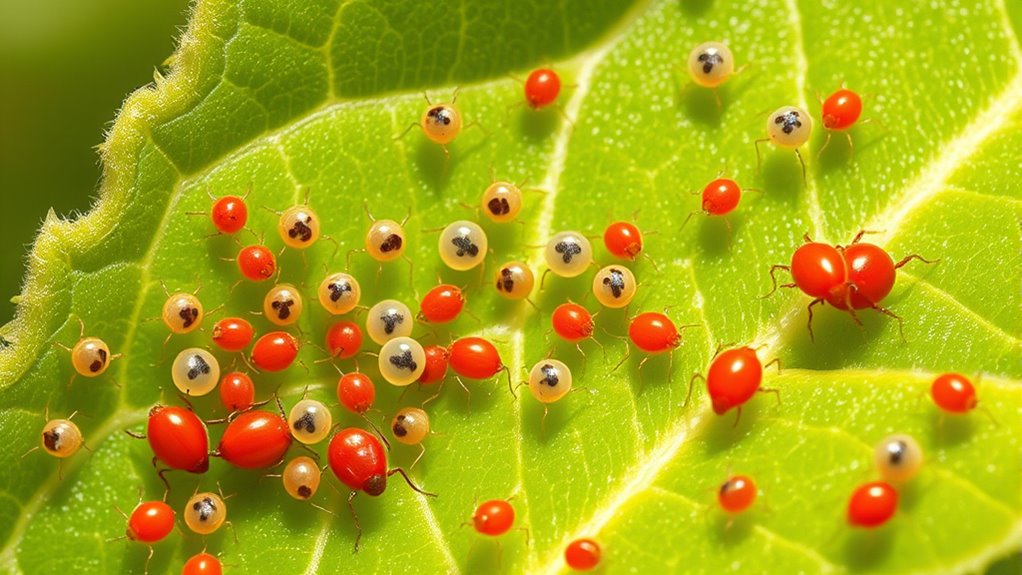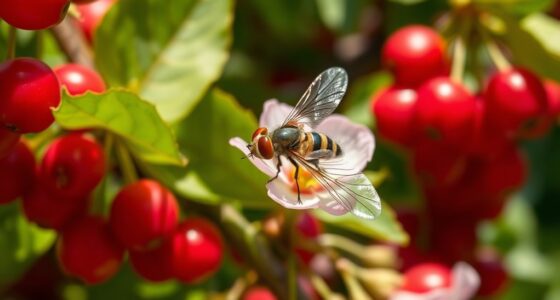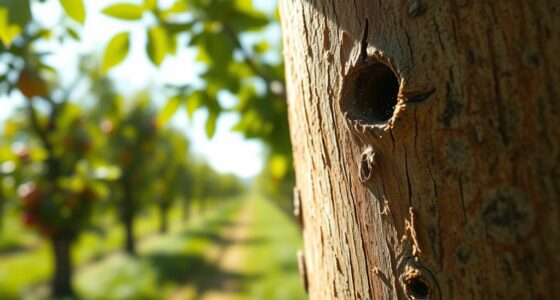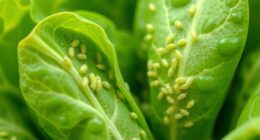In your orchard, you’ll notice two-spotted mites, which have black spots on their bodies, and European red mites, characterized by their bright red color. Both prefer warm, dry conditions and feed on leaf sap, causing stippling, bronzing, and leaf drop. Managing them involves regular scouting, applying targeted treatments, and encouraging natural predators. Understanding their differences helps you protect your trees better—keep exploring to find effective strategies and keep these pests at bay.
Key Takeaways
- Two-spotted mites are small with black spots, while European red mites are bright red and more visible during infestations.
- Two-spotted mites prefer dry, warm conditions and feed mainly on undersides of leaves; European red mites favor upper leaf surfaces.
- Both pests cause leaf stippling, bronzing, and damage to fruit development, impacting crop yield.
- Management includes regular scouting, targeted miticides, natural predators, and orchard hygiene practices.
- Early detection and an integrated approach help prevent severe infestations and support orchard health.
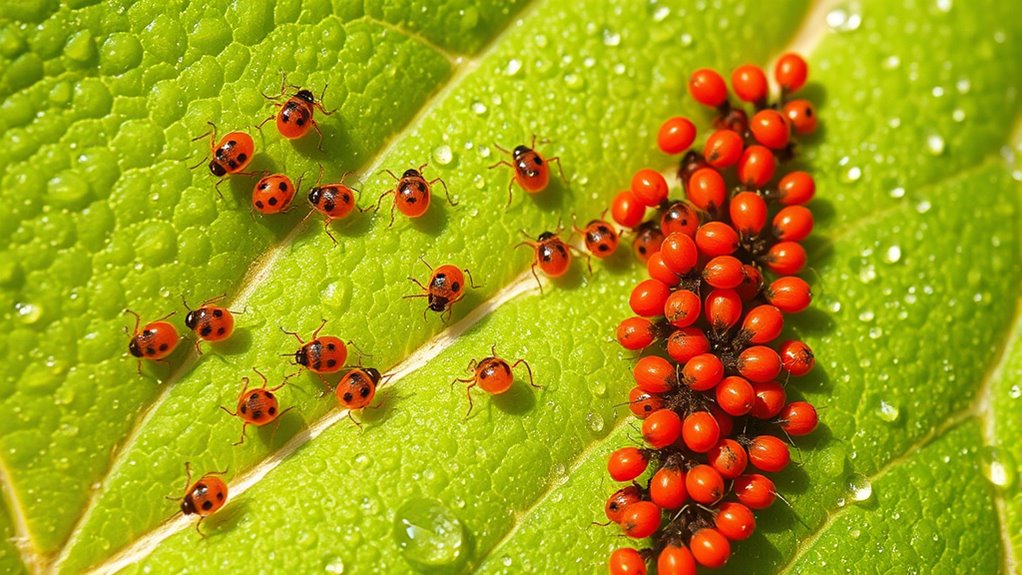
Have you noticed tiny pests causing trouble in your orchard? If so, you’re likely dealing with mites, small arachnids that can cause significant damage if left unchecked. These pests are often hard to spot with the naked eye, but their effects are visible—stunted growth, leaf discoloration, and even fruit deformities. Effective mite control is crucial to maintaining orchard health, preventing infestations from spiraling out of control and affecting your crop yield. Recognizing the different types of mites, especially the two-spotted mite and the European red mite, can help you implement targeted strategies to combat them and protect your orchard’s vitality.
Tiny orchard pests like mites cause visible damage; early detection and targeted control are essential.
The two-spotted mite is a common pest that can cause considerable harm during warm, dry seasons. These mites are tiny, often only visible under a magnifying glass, with distinctive black spots on their bodies, which makes them easier to identify. They tend to congregate on the undersides of leaves, where they feed on plant sap, leading to stippling and bronzing of the foliage. As their numbers increase, leaves may turn yellow and drop prematurely, weakening the overall plant and reducing fruit production. Mite control for these pests involves regular scouting, especially during peak seasons, and applying appropriate miticides at the first signs of infestation. Introducing natural predators, such as predatory mites, can also help keep populations in check without harming your orchard’s ecosystem. Keeping the orchard well-irrigated and avoiding excessive nitrogen fertilizers can make your trees less attractive to these pests, further supporting your mite control efforts and orchard health.
On the other hand, the European red mite is easily identified by its bright red coloration, which becomes more prominent during infestations. These mites prefer the warmer parts of the growing season and tend to settle on the upper surfaces of leaves, where they feed and reproduce rapidly. Their feeding causes leaf stippling, bronzing, and in severe cases, leaf drop, which hampers photosynthesis and hampers fruit development. Mite control for European red mites requires an integrated approach. Regular monitoring can help you catch infestations early, and applying miticides specifically effective against this species can prevent them from spreading. Also, pruning heavily infested branches and maintaining good orchard hygiene can reduce hiding spots and breeding grounds for these mites. Encouraging beneficial insects, like ladybugs and lacewing larvae, can naturally suppress European red mite populations, contributing to your overall orchard health.
Dealing with these mites demands vigilance and timely action. Understanding their behaviors and preferred environments allows you to craft effective control strategies that minimize chemical use and support a healthy, productive orchard. When you stay proactive and integrate various mite control methods, you’re not only protecting your trees but also promoting a resilient orchard ecosystem. This balanced approach ensures your orchard remains healthy, fruitful, and less vulnerable to the persistent threat posed by these tiny pests.
Frequently Asked Questions
How Do Mites Affect Apple Crop Yields?
Mites can considerably reduce apple crop yields by feeding on leaves, fruit, and buds, which hampers photosynthesis and fruit development. Understanding mite biology helps you identify infestations early, allowing for timely orchard management. Proper monitoring and targeted treatments control mite populations, preventing extensive damage. By staying vigilant and applying integrated pest management strategies, you protect your trees, ensuring healthy growth and ideal fruit production throughout the season.
Are There Natural Predators to Control These Mites?
Yes, there are natural predators that help control these mites through biological control. Beneficial insects like lady beetles, predatory mites, and lacewing larvae actively feed on mite populations, reducing their numbers naturally. You can encourage these beneficial insects by avoiding broad-spectrum pesticides and planting habitat diversity. Biological control offers an eco-friendly way to manage mite infestations, helping protect your orchard’s health without harming beneficial insect populations.
Can Mites Survive Winter in Orchard Environments?
Like tiny winter travelers, mites can survive orchard microclimates through mite overwintering strategies. Despite the cold, some mites hide in leaf litter, bark crevices, or dormant buds, making survival possible. Your orchard’s microclimates can create safe havens, allowing mites to endure winter months. To manage them effectively, understand these overwintering sites and adjust your pest control practices accordingly, preventing a spring resurgence.
What Signs Indicate Mite Infestation Before Damage Appears?
You can spot signs of mite infestation early by observing mite identification cues like tiny specks or webbing on leaves. Regular inspections using early detection methods, such as gently shaking branches over a white sheet, help reveal mites before damage shows. Look for stippling, discoloration, or leaf curling, which are initial indicators. Catching these signs early allows you to manage the problem effectively before it harms your orchard’s health.
Are Chemical Treatments Safe for Organic Orchards?
Chemical treatments can be safe for organic orchards if you choose organic pesticides approved for organic farming. Always follow label instructions carefully. Using integrated pest management (IPM) strategies helps you minimize chemical use and target mites effectively. Combine organic pesticides with biological controls and cultural practices to keep mite populations in check while maintaining the orchard’s organic integrity. Regular monitoring guarantees treatments are applied only when necessary, protecting your orchard’s health and sustainability.
Conclusion
Just like a tiny spark can ignite a wildfire, a small mite can cause big damage in your orchard. I remember one season when a sudden surge of two-spotted mites nearly wiped out a fruit crop, reminding me how vital early detection is. Keep a close eye on your trees, whether it’s the two-spotted or the European red mite, because catching them early is like putting out a small flame before it turns into an uncontrollable blaze.
